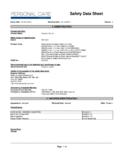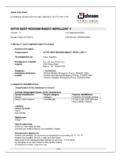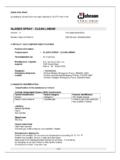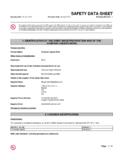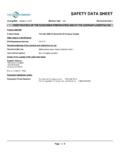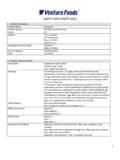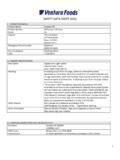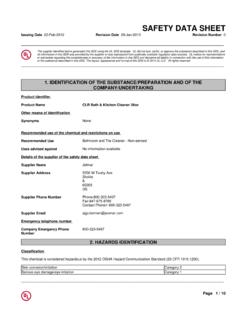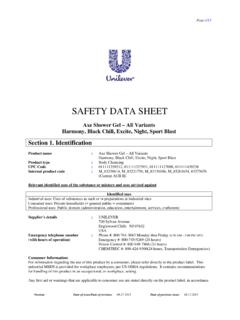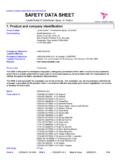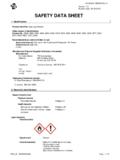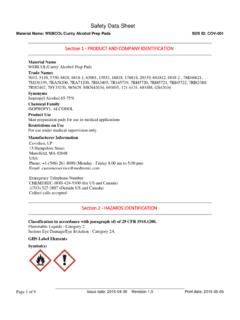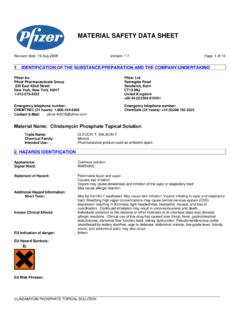Transcription of Safety Data Sheet - GJ Food
1 Safety data Sheet Issue Date 11-Jul-2013 Revision Date: 16-Jul-2013 Version 1. 1. IDENTIFICATION. Product Identifier Product Name Glass Cleaner Other means of identification SDS # PCP-089. Product Code 92536/Glass Cleaner with Trigger/48155-92536. 90629/Glass Cleaner/48155-90629. Recommended use of the chemical and restrictions on use Recommended Use Glass cleaner. Details of the supplier of the Safety data Sheet Supplier Address Personal Care Products LLC. 3001 West Big Beaver Rd. Ste. 520. Troy, MI 48084. Emergency Telephone Number Company Phone Number 248-971-7600. Emergency Telephone (24 hr) INFOTRAC 1-352-323-3500 (International). 1-800-535-5053 (North America).
2 2. HAZARDS IDENTIFICATION. Classification This chemical does not meet the hazardous criteria set forth by the 2012 OSHA Hazard Communication Standard (29 CFR. ). However, this Safety data Sheet (SDS) contains valuable information critical to the safe handling and proper use of this product. This SDS should be retained and available for employees and other users of this product. Physical State Liquid 3. COMPOSITION/INFORMATION ON INGREDIENTS. Chemical Name CAS No Weight-%. Water 7732-18-5 >90. Ethylene Glycol Monobutyl Ether 111-76-2 <1. Isopropyl alcohol 67-63-0 <1. Ammonium hydroxide 1336-21-6 <1. EDTA 60-00-4 <1. _____. Page 1 / 7. PCP-089 - Glass Cleaner Revision Date: 16-Jul-2013.
3 _____. 4. FIRST-AID MEASURES. First Aid Measures Eye Contact Rinse thoroughly with plenty of water for at least 15 minutes, lifting lower and upper eyelids. Consult a physician. Skin Contact Wash off immediately with plenty of water for at least 15 minutes. Inhalation Remove to fresh air. Ingestion Clean mouth with water and drink afterwards plenty of water. Most important symptoms and effects Symptoms Direct contact with eyes may cause temporary irritation. Indication of any immediate medical attention and special treatment needed Notes to Physician Treat symptomatically. 5. FIRE-FIGHTING MEASURES. Suitable Extinguishing Media Use extinguishing measures that are appropriate to local circumstances and the surrounding environment.
4 Unsuitable Extinguishing Media Not determined. Specific Hazards Arising from the Chemical Non-flammable. Protective equipment and precautions for firefighters As in any fire, wear self-contained breathing apparatus pressure-demand, MSHA/NIOSH (approved or equivalent) and full protective gear. 6. ACCIDENTAL RELEASE MEASURES. Personal precautions, protective equipment and emergency procedures Personal Precautions Use personal protective equipment as required. Methods and material for containment and cleaning up Methods for Containment Prevent further leakage or spillage if safe to do so. Methods for Clean-Up Keep in suitable, closed containers for disposal. 7. HANDLING AND STORAGE.
5 Precautions for safe handling Advice on Safe Handling Handle in accordance with good industrial hygiene and Safety practice. Conditions for safe storage, including any incompatibilities Storage Conditions Keep containers tightly closed in a dry, cool and well-ventilated place. Incompatible Materials Strong acids. _____. Page 2 / 7. PCP-089 - Glass Cleaner Revision Date: 16-Jul-2013. _____. 8. EXPOSURE CONTROLS/PERSONAL PROTECTION. Exposure Guidelines Chemical Name ACGIH TLV OSHA PEL NIOSH IDLH. Ethylene Glycol Monobutyl Ether TWA: 20 ppm TWA: 50 ppm IDLH: 700 ppm 3. 111-76-2 TWA: 240 mg/m TWA: 5 ppm 3. (vacated) TWA: 25 ppm TWA: 24 mg/m 3. (vacated) TWA: 120 mg/m (vacated) S*.
6 S*. Isopropyl alcohol STEL: 400 ppm TWA: 400 ppm IDLH: 2000 ppm 3. 67-63-0 TWA: 200 ppm TWA: 980 mg/m TWA: 400 ppm 3. (vacated) TWA: 400 ppm TWA: 980 mg/m 3. (vacated) TWA: 980 mg/m STEL: 500 ppm 3. (vacated) STEL: 500 ppm STEL: 1225 mg/m 3. (vacated) STEL: 1225 mg/m Appropriate engineering controls Engineering Controls Apply technical measures to comply with the occupational exposure limits. Individual protection measures, such as personal protective equipment Eye/Face Protection Avoid contact with eyes. Skin and Body Protection Wear suitable protective clothing. Respiratory Protection Ensure adequate ventilation, especially in confined areas. General Hygiene Considerations Handle in accordance with good industrial hygiene and Safety practice.
7 9. PHYSICAL AND CHEMICAL PROPERTIES. Information on basic physical and chemical properties Physical State Liquid Appearance Not determined Odor Not determined Color Not determined Odor Threshold Not determined Property The following physical data are Remarks Method approximate only and do not represent specification values. They should be used only in the context of this Safety data Sheet . pH >7. Melting Point/Freezing Point ~ 0 C / ~32 F. Boiling Point/Boiling Range ~ 100 C / ~212 F. Flash Point Non-flammable Evaporation Rate ~1 (Water = 1). Flammability (Solid, Gas) n/a-liquid Upper Flammability Limits Not applicable Lower Flammability Limit Not applicable Vapor Pressure Similar to water Vapor Density Similar to water Specific Gravity ~1 (1=Water).
8 Water Solubility Soluble in water Solubility in other solvents Soluble in some polar solvents Partition Coefficient Little partitioning Autoignition Temperature Does not auto-ignite Decomposition Temperature Not determined _____. Page 3 / 7. PCP-089 - Glass Cleaner Revision Date: 16-Jul-2013. _____. Kinematic Viscosity Not viscous Dynamic Viscosity Not viscous Explosive Properties Not an explosive Oxidizing Properties Not determined 10. STABILITY AND REACTIVITY. Reactivity Not reactive under normal conditions. Chemical Stability Stable under recommended storage conditions. Possibility of Hazardous Reactions None under normal processing. Conditions to Avoid Keep out of reach of children.
9 Incompatible Materials Strong acids. Hazardous Decomposition Products None known based on information supplied. 11. TOXICOLOGICAL INFORMATION. Information on likely routes of exposure Product Information Eye Contact Avoid contact with eyes. Skin Contact Avoid contact with skin. Inhalation Avoid breathing vapors or mists. Ingestion Do not taste or swallow. Component Information Chemical Name Oral LD50 Dermal LD50 Inhalation LC50. Ethylene Glycol Monobutyl Ether = 470 mg/kg ( Rat ) = 2270 mg/kg ( Rat ) = 220 mg/kg = mg/L ( Rat ) 4 h = 450 ppm 111-76-2 ( Rabbit ) ( Rat ) 4 h Ammonium hydroxide = 350 mg/kg ( Rat ) - - 1336-21-6. Isopropyl alcohol = 4396 mg/kg ( Rat ) = 12800 mg/kg ( Rat ) = 12870 = mg/L ( Rat ) 4 h 67-63-0 mg/kg ( Rabbit ).
10 EDTA = 1700 mg/kg ( Rat ) - - 60-00-4. Information on physical, chemical and toxicological effects Symptoms Please see section 4 of this SDS for symptoms. _____. Page 4 / 7. PCP-089 - Glass Cleaner Revision Date: 16-Jul-2013. _____. Delayed and immediate effects as well as chronic effects from short and long-term exposure Carcinogenicity Isopropyl Alcohol (IPA) is listed as an IARC Monograph Group 3 chemical. However, IARC. Group 3 chemicals are "not classifiable as human carcinogens". IPA is classified as an IARC Group 1 chemical ONLY when manufactured by the strong-acid process. The IPA. used in this product is NOT manufactured by the strong-acid process and is therefore not classifiable as a human carcinogen.
